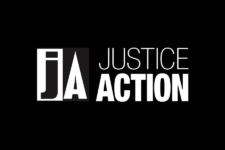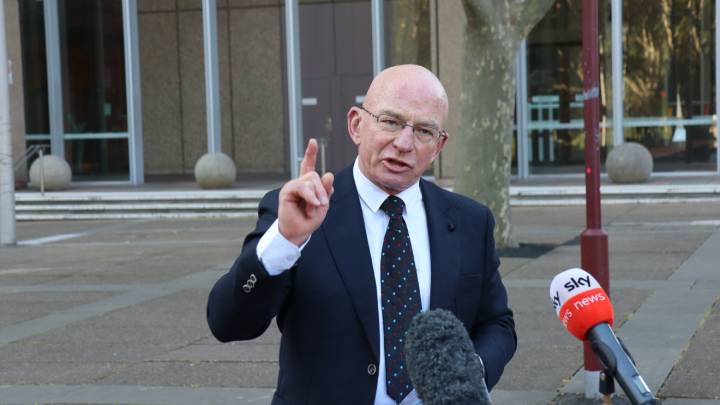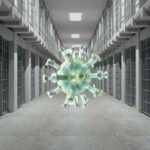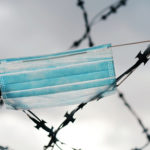COVID Prisoners Defence Class Action: An Interview With Justice Action’s Brett Collins

As the state of NSW focuses on opening up from the COVID lockdown and living with the virus, prisoners in this state’s correctional facilities are already having to do that, but a stark difference from the outside is most remain unprotected, and this is not by choice.
The outbreak in the NSW prison system became apparent in late August, and all correctional facilities have been in lockdown since then.
Inmates can’t socially distance, while other protective measures are lacking, and the 24 hour confinement some endure is a measure akin to torture.
In late August, only 21 percent of inmates and 40 percent of staff had been vaccinated. This is despite ATAGI having cited prisoners as a priority population for inoculation. And as of last week, around a third of the 13,000 people detained in state correctional facilities had received two jabs.
As of 17 September, there had been at least 325 COVID cases amongst the NSW prisoner population, with 84 of those involving First Nations people. Forty correctional staff members had also tested positive statewide.
And at the flashpoint of the outbreak, the privately-run Parklea prison, at least 140 inmates have tested COVID positive.
Taking action
Prisoners’ rights organisation Justice Action has launched a class action in the NSW Supreme Court, calling on Corrective Services NSW (CSNSW) acting commissioner Kevin Corcoran to take a number of steps to ensure the safety of inmates during the pandemic, rather than simply locking them down.
Chief amongst these advised actions is exercising a law that the Berejiklian government enacted in March last year, when it passed an omnibus emergency powers bill to permit drastic actions to be taken during the public health crisis.
Section 276 of the Crimes (Administration of Sentences) Act 1999 (NSW) contains this COVID-19 specific power, which enables the release of low-risk inmates who have a pre-existing medical condition or are vulnerable to the virus and are eligible for parole within the next 12 months.
Another priority concern that lawyers, prisoner advocates and family members are pushing for is the rollout of computer tablets into the cells, so that locked down prisoners can contact family and their legal representatives, as there have been reports of phone calls being cut off or refused.
Action the release law
Founded by Brett Collins in 1979, Justice Action is a not-for-profit that advocates for the rights of prisoners and involuntary mental health patients. The civil society organisation has played a key role in shaping Australian criminal justice policy over the last four decades.
Collins told the NSW Public Accountability Committee inquiry into the state’s COVID response that his organisation has been calling on CSNSW to use the emergency measure since the beginning of the year, yet the same density of inmates within the system remains.
Sydney Criminal Lawyers spoke to Justice Action coordinator Brett Collins about the current conditions prisoners are facing, the benefits that computer tablets would bring to those in lockdown, and the six actions the court challenge is calling on the acting commissioner to take.

Firstly, the news of COVID outbreaks in the NSW prison system broke at the end of August. Silverwater, Bathurst, and in particular Parklea, prisons have all been affected.
However, the attention given to this matter by NSW authorities seems to be negligible, and the continuing COVID crisis on the inside is receiving little media attention.
Brett, in your understanding, what’s the state of the COVID-19 crisis in NSW correctional facilities at present?
Currently, prisoners themselves are cowering behind locked doors. There is a general acceptance that COVID will rip through the prisons. Last week, we had some 370 people who were infected.
But the way the figures are presented, depends on who is telling the story. We had a report from the Parklea governor last week. He said there were only seven people infected.
So, what happened to all the others? The way he sees it, if a person is no longer infectious then it ends the matter.
So, the crisis has escalated dramatically since it was first reported in late August?
Absolutely. And we expect it to keep on expanding. The COVID narrative in the general community is we have to live with the virus. But everyone has forgotten about the situation of the people in prison, who can’t defend themselves.
They’re left waiting like sitting ducks: waiting for an infected person to come into their cell, or they have to move through an area where an infected person has just come into.
Transferring through a prison is very different from the situation in the general community.
There are security points, where every prisoner has to move through a certain area to be permitted to enter into a new space or pick up food from a trolley or receive medical attention in a clinic.
They all have to go through these chokepoints. One person infected with the virus can go through and pass it onto others.
Inevitably, it will run through the prison system in the same way that it has done in the US.
In regard to the lack of action being taken by Corrective Services NSW, Justice Action, along with the families of prisoners and Jailing Truths Exposed, are launching a class action calling on the authorities to do something about this “ticking timebomb”.
What does the legal action involve? And what does it seek to achieve?
It will be a class action injunction. We have the names of 12 plaintiffs, who are representative of the prisoner population. It represents all prisoners throughout the system.
There are six points in the relief claim. Most importantly, is the obligation that there be four square metres per person, as in the general community.
Any employer or manager of a premises has an obligation to ensure four square metres per person. That is what the Health Department insists on.
That is all we are saying as our first claim: that the four square metre rule should be accepted and abided by.
We are asking that acting commissioner Kevin Corcoran achieve that. Of course, he can’t, as he’s got cells that are only seven square metres, with two prisoners sitting side by side. Therefore, it means those cells must only hold one person.
So, if he can’t maintain the accommodation for the current 13,000 prisoners where they are safe, then he must use that special legislation – the COVID-19 Legislation Amendment (Emergency Measures) Act 2020 – to reduce overcrowding and release those people for whom he has authority.
There are people who are currently serving less than 12 months, or are 12 months away from their release date, who should be released on parole.
It would be a safe release of prisoners. They would be out of prison shortly anyway. It means that those people who are still in prison will be able to abide by the health and safety rules.
There are a few other things we want to achieve, such as cleaning, and currently, there is no PPE or hand wash for people.
Then there are vaccinations. There needs to be vaccinations for prisoners and guards. Guards have got to be vaccinated in the same way as aged care workers are required to be vaccinated.
There should be an opportunity for vaccination for all prisoners as well. It is totally wrong that prisoners who are classed as a highest priority group by ATAGI, along with people in aged care homes, are still not vaccinated.
That’s appalling. Twenty one percent of people in prison had been vaccinated when the outbreak began, as opposed to double and triple that in the general community.
It is totally wrong. People have been refused vaccinations.
As you’ve mentioned, part of this action involves calling on CSNSW to exercise a law that permits certain inmates to be released early.
At the start of the prison crisis, acting commissioner Kevin Corcoran stated that he found 1,000 inmates would be captured by this mechanism, but he then said that once this was cut down, he thought only about 200 would be eligible, so he wasn’t going to bother.
What did you think about this approach by the acting commissioner?
That’s ridiculous. It is quite clear that there is a very significant portion of people who are close to release.
They are people who are awaiting parole as it stands now. And many people have been waiting longer because of COVID. People haven’t been able to do the courses that they should be doing and that has prevented them from being released on parole.
These people should be released by the acting commissioner as well. He could release a thousand prisoners straightaway.
This wouldn’t decrease safety in the community at all. These people are going to come out shortly anyway.
And a lot of people are in there for short periods. A lot of them are in there waiting for parole. They could be safely returned to the community with proper support.
The current annual amount that we’re paying to imprison them – around $100,000 a person – could easily be used to set up a person in accommodation and ensure that they are safe.
What about the conditions prisoners are facing right now? Are they in lockdown? And will the class action address this?
Yes. People are currently being locked in their cells all day. Some people have been in their cells seventeen days at a time, without leaving them. These are documented occasions.
Other people are being left in their cells, and only getting out for 10 minutes. That’s actually a breach.
There is clause 53(2) of the Crimes (Administration of Sentences) Regulation 2014 (NSW), which states that prisoners who are confined to their cells must be allowed out of them for at least one hour a day.
Seeing that acted upon is another issue in our summons. The last issue is access to communication inside the cell.
There has been a promise over a long period that there would be a computer tablet in each of the cells so that prisoners can have access to their legal representatives, mental health services and their families, as well as access to what are called “whitelisted” websites, which are rehabilitation and educational services.
That had been promised. And in this situation where prisoners are not getting access to the services they would normally get – like access to rehab or legal services – it’s a breach of their entitlements.
Computer tablets are an important issue that could be seen to straightaway.
Justice Action put it to the Parklea governor Paul Baker, that we’ve got a thousand tablets which are available to be delivered to the prisoners in that prison. And we inquired as to how we could go about delivering them.
Baker came back on Friday with an agreed statement, which says:
“On the Justice Action offer to donate tablet computers to all Parklea prisoners in their cells, the governor said that the monetary costs were not the concern.
Justice Action reported that for $250,000 the prison could be serviced by a specialist secure server with wireless access points to supply every prisoner with a secure phone and internet service in their cells. This service is applicable to all prisons like Goulburn.
Mr Baker said that the ongoing pandemic had preoccupied his highest priorities. So, that was why that development hadn’t progressed at the same pace as the public prisons. He also mentioned that telephone port access exists in the cells, but they are not switched on.
Mr Baker said this was for prisoners to receive rehabilitation and educational services from the services Parklea was providing during the seven and half hours prisoners are out of their cells.
Justice Action pointed out that the Corrective Services NSW commissioner had agreed to provide access to whitelisted websites, where mainstream education services would be available to all prisoners in their cells at no cost to the prison. These services would be available during cell time.
He agreed that would be valuable. We asked what the timetable would be. And the governor said he is uncertain.”
That’s the sixth point in our summons.
So, the prison COVID crisis has been going on for about a month now. What have the authorities been doing to alleviate the outbreak in the system?
They haven’t been doing anything. From all the reports from inside the prisons, the best thing that has been happening now is at least people are beginning to be able to talk. But talking is just relieving the pressure.
All we are getting now is families who are being badly affected and are so concerned. We haven’t heard any reports about the commissioner using his special powers.
We have heard people are being released on bail. And we hear some people are being released from prison as usual. We assume there are some discretions being used to get some people out.
But there has not been an action by the authorities to ensure people get out of their cells, with time for exercise, because of the lockdown chaos.
There are high tensions running through the system, as it waits for the time bomb to go off.
So, lastly, Brett, Justice Action lodged the notice of the class action with the NSW Supreme Court last Thursday. What’s next from here?
The good thing is a whole range of lawyers have come in to give us a hand. We’d originally had some lawyers who were only interested in low hanging fruit, like getting in masks and other safety measures.
But the message from families is there should be releases. So, we’ve advanced on that.
We’ve also got a GoFundMe page raising $50,000, which will help with the computer tablets, the services that follow through from there, and also the legal costs.
We’re going to make sure that we see some changes there that will make lives in prison acceptable and ensure that at least some people are released pursuant to the court case.
And there will definitely be a focus on what is happening in the prisons, both through the court case and also through a series of Facebook pages, which are churning information and receiving a lot of reports.







